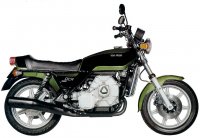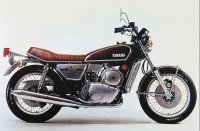-
Enjoy XS650.com? Consider making a donation to help support the site.
XS650.com receives a small share of sales from some links on this page, but direct donations have a much greater impact on keeping this site going.
You are using an out of date browser. It may not display this or other websites correctly.
You should upgrade or use an alternative browser.
You should upgrade or use an alternative browser.
Engine Design Questions
- Thread starter xs650-4-me
- Start date
Never went into production but a very tidy looking 72 RZ201Yamaha Rotery 660cc
View attachment 131815
Well, that’s a new one to me. Good one Skull!
I don't specifically know about the W16 but I would imagine it works a lot like the other VW group W engines. In another lifetime I was a VW dealer tech and read through the training material for the W 8 and 12 engines. Rather than thinking of them as 4 banks of cylinders it's actually more appropriate to view them as 2 narrow angle engines on a common crankshaft. The way the narrow angle engines run is actually just like an inline six because of the way the crank pins are off ground.
That being said, firing interval wise, the W 16 would be like the craziest looking 90* V16 you've ever seen.
Incidentally there was a great line in the training manual. Something to the idea of "Because of the angle of the cylinder banks a ten cylinder engine would have perfect primary and secondary balance. The W engines will be offered in 8 and 12 cylinder versions"
All that having been said, wasn't there a Benelli triple back in the day that fired the outer cylinders at once and then the middle one 360* later?
That being said, firing interval wise, the W 16 would be like the craziest looking 90* V16 you've ever seen.
Incidentally there was a great line in the training manual. Something to the idea of "Because of the angle of the cylinder banks a ten cylinder engine would have perfect primary and secondary balance. The W engines will be offered in 8 and 12 cylinder versions"
All that having been said, wasn't there a Benelli triple back in the day that fired the outer cylinders at once and then the middle one 360* later?
FWIW, the only design free from vibration is a bicycle! 

How come I can't reliably remember my son's girlfriend's name (or what I had for breakfast) but if someone says Wankel engines I just say, "Oh, yeah. The Suzuki RE5, of course. 1974 to 1976."
xs650-4-me
XS650 Enthusiast
I'd be a little surprised if the Suzuki GT750 (or Kawi H2) were 'externally' balanced...ok, maybe a lot surprised.
I've seen the Suzuki rotary, would rather have another XS !
Had a few BMW boxers in my day, prefer the K75 though. Everything has it's day and time I guess. The boxer was a great MC...didn't the Nazis use them too ?
I've seen the Suzuki rotary, would rather have another XS !
Had a few BMW boxers in my day, prefer the K75 though. Everything has it's day and time I guess. The boxer was a great MC...didn't the Nazis use them too ?
Back in the day, I had the hots for the Van Veen OCR 1000.

Another diversion:
http://www.xs650.com/threads/the-animated-engine-thread.40156/

Another diversion:
http://www.xs650.com/threads/the-animated-engine-thread.40156/
Back in the day, I had the hots for the Van Veen OCR 1000.
View attachment 131832
Another diversion:
http://www.xs650.com/threads/the-animated-engine-thread.40156/
Yet another rotary I didn’t know existed. I kinda think they pulled it off better than most.
I like that Van Veen - it’s a very handsome bike.
Rotaries have nearly sunk several companies over the years (certainly Suzuki regretted ever trying it). Between their poor volumetric efficiency (i.e lousy fuel economy) and dreadful emissions characteristics (just check out the size of the catalytic converster on a Mazda RX7) I doubt you will ever see one in production again.
Rotaries have nearly sunk several companies over the years (certainly Suzuki regretted ever trying it). Between their poor volumetric efficiency (i.e lousy fuel economy) and dreadful emissions characteristics (just check out the size of the catalytic converster on a Mazda RX7) I doubt you will ever see one in production again.
Never say never. As technology advances ideas that didn't work well before can become state of the art.I like that Van Veen - it’s a very handsome bike.
Rotaries have nearly sunk several companies over the years (certainly Suzuki regretted ever trying it). Between their poor volumetric efficiency (i.e lousy fuel economy) and dreadful emissions characteristics (just check out the size of the catalytic converster on a Mazda RX7) I doubt you will ever see one in production again.
X77S
Let's do this!
Dorito power Intrigues me. Probably never own one but I love the sound. It's just NASTY!
Max Midnight
XS650 Addict
II doubt you will ever see one in production again.
Good job you didn't put money on that Pete.
Have a look here
Between their poor volumetric efficiency (i.e lousy fuel economy) and dreadful emissions characteristics (just check out the size of the catalytic converster on a Mazda RX7)
I'm not an expert on rotary engines, but do they really have poor volumetric efficiency or are you just conflating volumetric efficiency with fuel economy? I would think the power production given the relatively small physical size would indicate high volumetric efficiency where the poor combustion chamber shape and need to run rich for longevity lead to the poor fuel efficiency. Likewise it's been my understanding that the larger catalytic convertor was due to the unusually high (for a road car) exhaust gas temperatures.
Again, I'm not correcting as I don't know the answer to these, just asking.
Well, I’m not an expert on rotaries either, but I’ve been told by folks who are that they are very thirsty and have emission which are difficult to clean up in addition to the high exhaust temperatures.
Now, if you think of it, that all sort of makes sense - when you buy gasoline,you’re never t doing to warm up the atmosphere, you really just want to go down the road. The fact that the exhaust is so hot means that an awful lot of the energy you paid for is simply going out the tailpipe.
Now, if you think of it, that all sort of makes sense - when you buy gasoline,you’re never t doing to warm up the atmosphere, you really just want to go down the road. The fact that the exhaust is so hot means that an awful lot of the energy you paid for is simply going out the tailpipe.
mike in idaho
XS650 Addict
Back in the sixties, BRM campaigned a formula car with a 16 cylinder engine. Two opposed eight cylinder engines with the cranks geared together in a common crankcase. They spent a ton of time and money trying to develop it, lots of problems and broken parts. They finally gave up on it and developed a more conventional design later.
yamageddon
XS650 Addict
Back in the day, I had the hots for the Van Veen OCR 1000.
View attachment 131832
Another diversion:
http://www.xs650.com/threads/the-animated-engine-thread.40156/
Only 38 were built, the reason was that the engine supplier stopped production. The engine was intended for a Citroën GS (French car) which of course also never happened. Funny thing is by 2011, the leftover OCR 1000 parts had been purchased by Andries Wielinga, who built 10 complete motorcycles for sale. It's a very rare motorcycle. Seen one only once in real life at a meet many years ago.
Henk van Veen, the founder of Van Veen OCR1000 was the importer of Kreidler motorcycles and mopeds. Kreidler&VanVeen also made the very successful 50cc racers:
Two stroke 50cc wasps that made about 18,000 rpm(!)
Real men ride a Munch! 
You say you want smoooth? How about the Y2K jet bike?
You say you want smoooth? How about the Y2K jet bike?
Curious, IIRC xs650 pistons go up and down together right ? Seems to me there is no other way due to it being a 4-stroke with 'only' 2 cylinders.
Do all 2-cyl 4-stokes makers (Tri Nort etc) follow the same design ? they both go up/dn together ?
How about a 4cyl 4-stroke ? Do 2 go up and 2 go down in all designs ?
Would they alternate inside and outside or 2-odd and 2-even ? Seems like inside and outside pairs would balance the best.
What about 3-cyl 4-stroke ? Seems like it wouldn't balance all that well.
2 strokes are easy to figure out.
Hi 4-me,
here's what I know:-
2-stroke or 4-stroke makes no difference to an engine's balance.
Balancewise, up,n'down together parallel twins are just singles, they can't be balanced without adding counterbalancers
180º parallel twins have perfect primary balance but also have a nasty rocking couple which is fixed by putting 2 of them back to back in a straight 4.
90º V twins have perfect primary balance and no or a very small rocking couple depending on the crankpin design.
Flat twins have perfect primary balance and a very small rocking couple.
Other angled twins (45º. 60º. 270º etc) can be kinda balanced but never perfectly.
dps650rider
XS650 Addict
Biggest difference between a 4 stroke and 2 stroke is the spacing of firing impulses with various designs. A 180 2 stroke has an impulse every 180 degrees, with a 4 stroke you get two 180 degrees apart followed by nothing for 540 degrees. With an opposed (boxer) design a 4 stroke has an impulse every 360 degrees, with a 2 stroke both cylinders would fire at the same time. Years ago I saw one of these in a snowmobile but never heard it run.

